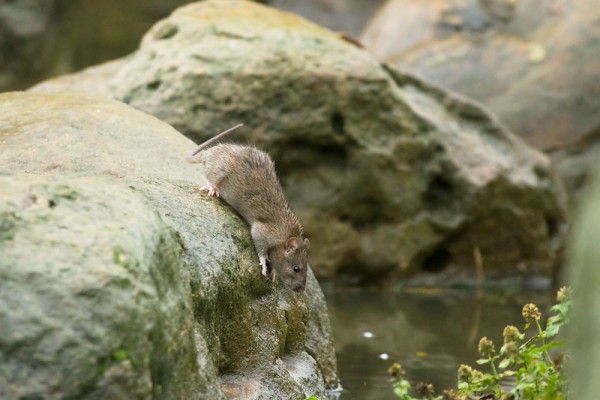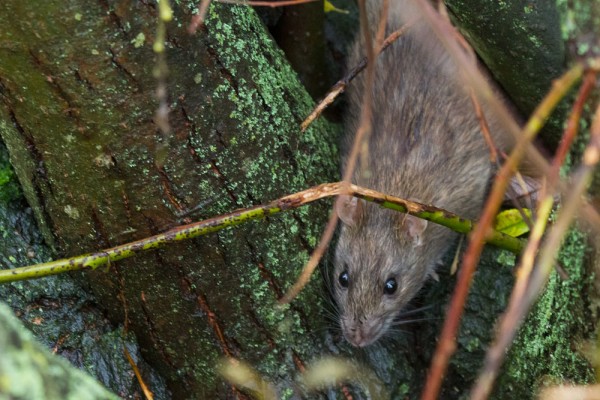It’s been very quiet this week. We’ve enjoyed (?) plenty of rain and mist, grey skies and a semi-permanent twilight. Not great for taking photos.
The main challenge of poor (i.e. low) light is the compromise between getting a fast shutter speed (needed to freeze the action) and keeping digital noise down. Getting a decent shutter speed means moving to a high ISO rating, but anything above 1600 (or even ISO 800) causes a lot of digital noise. Some of this can be removed with software, but the quality of the image suffers. If you go for a low ISO, the shutter slows to a crawl and the image blurs. This first shot of a rat was taken at ISO 3200 with a shutter speed of barely 1/25s. Actually surprisingly ok (and hand-held) but not something I want to try every day.
Later in the day the rats were at play and the light had improved. This one is at a tolerable ISO 1600 and 1/500s shutter.

Usable images, but a real struggle. That may all change very soon. I’m awaiting delivery of a Canon 7D Mark II, a long awaited and by all accounts much improved version of the 7D. High ISO performance should be a great deal better, focusing faster and more accurate (the auto-focus manual runs to 50+ pages alone, and supposedly auto-focus works in moonlight!). I should be getting mine in a week’s time (pre-ordered, so one of the first in the UK). I can’t wait to try it out, and for once I won’t be cursing the dimly lit mornings, and grey afternoons. Bring it on!
Camera note: all photos taken with the Canon 7D and EF 100-400mm f/4.5-5.6L USM IS lens.

Darko
25 Oct 2014Yes, it is always challenging to make a photo in a low light without getting blur or noise. I have a question for you. I am making photographs in RAW format for it gives me more opportunity to play with photographs and fix noise or low light problems but software that I am using is Digital Photo Professional that came with camera. And it has limited options so I always need to use Photoshop afterwards to give it a “final touch”. Do you know for something else I might use (but not too expensive)? Thanks!
Words
25 Oct 2014Darko, I shoot RAW and then do my initial edits in Adobe Lightroom as it’s the fastest way to manage so many images (DPP isn’t quite as flexible, but I have that as well). Lightroom is great for the main adjustments but I then export as a TIFF file and then do final tweaks in Photoshop (conversion to JPEG, size reduction final sharpening etc). Lightroom does allow you to export to jpg so in theory you could do everything there, but for some things photoshop is the best tool.
I tend not to spend more than a minute in each program per image.
Standalone version of Lightroom is reasonably priced. I’m not a fan of subscription software so I still work with Photoshop Elements.
Darko
26 Oct 2014I’ve heard about Lightroom but never really payed attention. Ok, thanks!